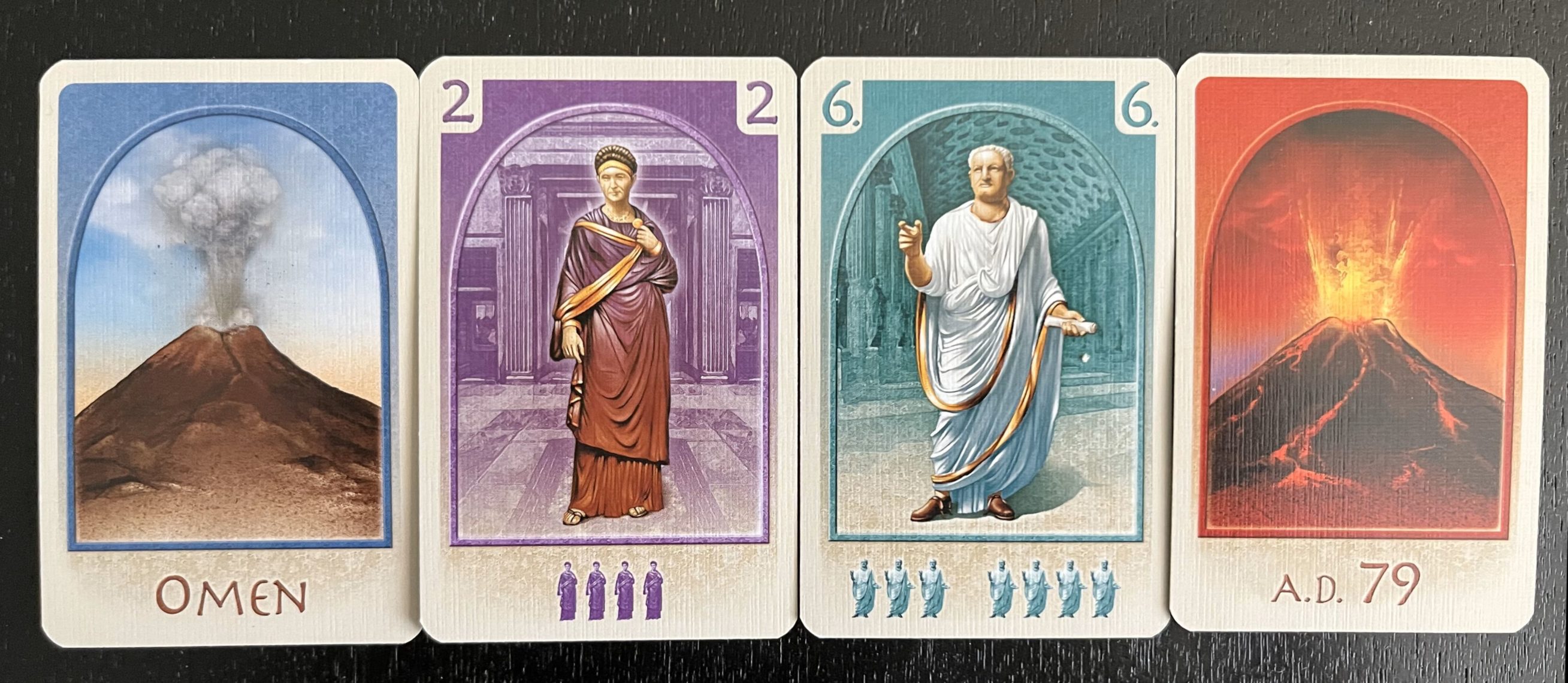I played The Downfall of Pompeii yesterday for the first time in years, and you know what? This almost-twenty-year-old game is like a breath of fresh air in 2023.
For one thing, it’s not defined by its mechanics. There’s a bit of this and a bit of that but no core mechanic. Instead, gameplay naturally flows around the story of settling a Roman town on the lip of a semi-active volcano and then running for the exits once the lava starts flowing. And this ain’t no Feldian point salad: you win by having the most dudes of your colour survive at the end of the game and that is that.

For the first few turns players simply take turns playing a card from hand to place one of their citizen-cylinders into the like-numbered building. Then they replenish their hand from a deck which has been seeded stochastically (ie randomly but somewhat predictably) with Omen and Eruption cards. Once the first Eruption is drawn players gain the ability to add multiple people to the town–but every time a player draws an Omen card they get to throw someone else’s dude into the ACTUAL FRICKIN VOLCANO and there is nothing more satisfying.

Oh, the humanity.
Everyone knows there are seven Omen cards in the deck but they turn up unpredictably so it’s definitely possible for one player to get hosed by the others. 2004 doesn’t care about your feelings, Trevor!
After the seventh Omen has come and gone it’s only a matter of time until the second Eruption card turns up and at this point you throw the cards into the box because now it’s a tile-laying game: the lava is going to flow, filling up the town and killing everything in its multiple paths, and you are going to desperately move your citizens to the nearest gate–until some schmuck blocks that exit with a lava tile. You’re never going to save everyone–but you just have to save more than everyone else.
But if all this sounds too chaotic and Munchkiny to you, I’ll point you to the game’s 7.1 rating on BGG and also the fact that it was designed by Klaus-Jürgen frickin’ Wrede, he of Carcassonne and…well, more Carcassonne. There is actually some very interesting strategy going on under the hood in both pre- and post-eruption parts of the game. It’s tempting at first to crowd your own pieces together apart from everyone else’s, but actually, in the tradition of games from Diplomacy to Modern Art to Terra Mystica, you want to be in the middle of the action with your pieces intermingled so that other players are incentivized not to lava you to death because then they’d be killing their own dudes off, too.

Obviously Downfall of Pompeii doesn’t have the heft of today’s dreadnoughts–”What?? The cards can only be used one way? Where are all the tracks?”–but you pooh-pooh it at your own risk. Everyone walking around stroking their chins asking “What kind of games bring more people into the hobby?” should take a serious look at Downfall of Pompeii for an example of a game with (a) a unique theme which (b) is totally integrated into gameplay and © can be taught in under ten minutes.
But I guess if Fantasy Flight ever reissued it it would have to become Star Wars: Downfall of Tatooine or something. Sigh.
COMPLETELY AGREE. The first time Taylor and I played this at GenCon a couple years ago, we first thought “what’s the big deal” and then we threw someone in the volcano and thought “Yasssssss!” Delightful game, a little thinky, but mostly just a bit puzzly and charming. Two thumbs up.